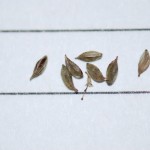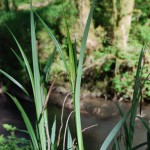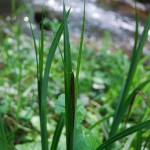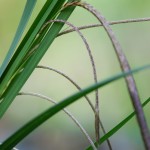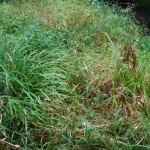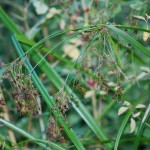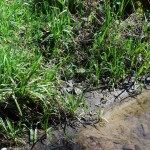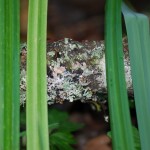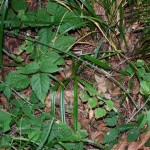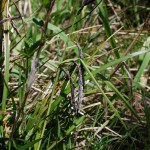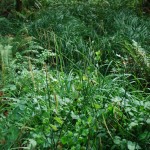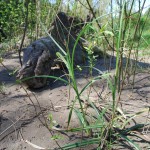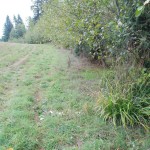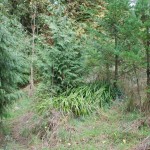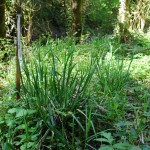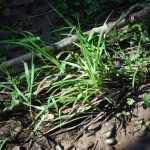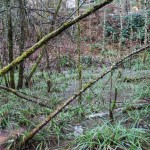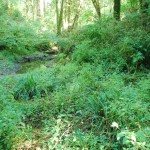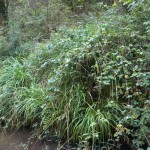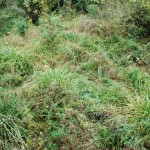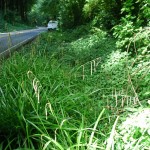Gallery:
- Very long culms extending at angle from the plant base.
- perigynia are elliptic, 2.6-4mm long, green to brown with a beak .5mm long and three stigmas. The achene inside is trigonous (three-sided).
- Drooping spikes photographed in March. The terminal spike is male and lateral spikes are all female.
- The terminal spike is male and emerges first in spring.
- Drooping spikes photographed in March. The terminal spike is male and lateral spikes are all female.
- Large C. pendula growing on incised bank and overhanging a small creek in Wilsonville, OR.
Common names:
drooping sedge, hanging sedge
Scientific Name:
Carex pendula
Description:
Carex pendula is an exotic, clump-forming sedge. It grows in full to partial shade in moist soils and has long and drooping inflorescences. Please see below for additional identification resources as there are similar native species.
Life cycle:
Height of mature plants
3-6 feet
Flower color:
Inconspicuous off-white flowers
Bloom time:
March through May
Look-a-likes:
There are several species present in our area that look similar to Carex pendula. Carex pendula belongs to a group of grass-like plants called sedges which, in general, are difficult to identify. Therefore, caution is advised when not experienced with this group of plants. After using this simplified resource, please consult an experienced Carex indentifier or technical manual such as the Flora of Oregon: Volume 1 or Field Guide to Sedges of the Pacific Northwest to confirm your identification. Also check out our plant identification resources.
Four key features need to be present to confirm your identification: dense tufts or clumped (cespitose) growth form, large plant size (culms and leaves), wide leaf blades, and long & drooping spikes. There are several species that have at least two of these characteristics including Carex amplifolia, Carex aquatilis var. dives, Carex cusickii, Carex obnupta, Carex hendersonii, Carex utriculata, and Scirpus microcarpus. Please review the below image gallery and chart that dissects each of these features and how Carex pendula compares with each look-a-like species. Species traits taken from Flora of Oregon: Volume 1 and field observations.
| Cespitose growth | Plant height | Wide leaf | Long & drooping spikes |
|
|
|
|
|
|
|
|
- Carex pendula (left) and Scirpus microcarpus (right) growing adjacent to each other surrounded by reed canarygrass. Typically Scirpus microcarpus is rhizomatous, but single mature plants are also observed as indicated in this photo. Note the distinctly different inflorescence of Scripus microcarpus.
- Scirpus microcarpus inflorescence
- Carex pendula (left) and Scirpus microcarpus (right) growing adjacent to each other. These can be distinguished based on their growth form: Scirpus microcarpus is rhizomatous and Carex pendula is cespitose (clumping).
- Carex pendula (top) and Scirpus microcarpus (bottom) growing adjacent to each other. These can be distinguished based on their growth form: Scirpus microcarpus is rhizomatous and Carex pendula is cespitose (clumping).
- Carex pendula (right) and Scirpus microcarpus (left) have similar leaf blades in width and color of the upper leaf surface, but can be distinguished based on lower leaf surface. Carex pendula has a less reflective, dull gray-green leaf underside while Scirpus microcarpus has a very reflective, apple green leaf underside.
- Carex pendula (left) and Scirpus microcarpus (middle) have similar leaf blades in width and are easily distinguished from the much smaller Carex obnupta (right).
- Carex pendula (center) seedling growing among Carex obnupta (surrounding center seedling).
- Carex obnupta has shorter drooping spikes than Carex pendula.
- Carex pendula (forground) growing adjacent to a large forested patch of Carex obnupta (background).
- This mature Carex pendula plant doesn’t appear to be growing in a cespitose manner, however, the lower leaves are likely removed by floodwaters and covered by deposited sediment.
- Carex amplifolia with ascending to spreading spikes.
- Carex aquatilis var. dives has shorter drooping spikes than C. pendula. Photo © 1998, Fred Weinmann
Habitat:
C. pendula is known to affect wetlands, streamsides, roadsides, and adjacent forested habitats in Oregon.
- field edge
- among restoration plantings
- floodplain bench
- cobble bar in small stream
- marshy detention pond
- small floodplain of small creek
- streambank
- floodplain
- roadside
Impacts:
Carex pendula has been observed in Clackamas County displacing native species along streams where in some cases it formed stands of 85% dominance. Assessing the distribution, impacts and potential impacts of this species requires more work and is a current project of the District.
Noxious Weed Listing:
- WeedWise: Priority
- State of Oregon: Watch
- State of Washington: Not listed
- Four County CWMA: Watch
- City of Portland: Class A
Origin:
Europe, North Africa
Links:
Invasive.org profile
CABI Invasive Species Compendium
USDA APHIS Weed Risk Assessment for Carex pendula


